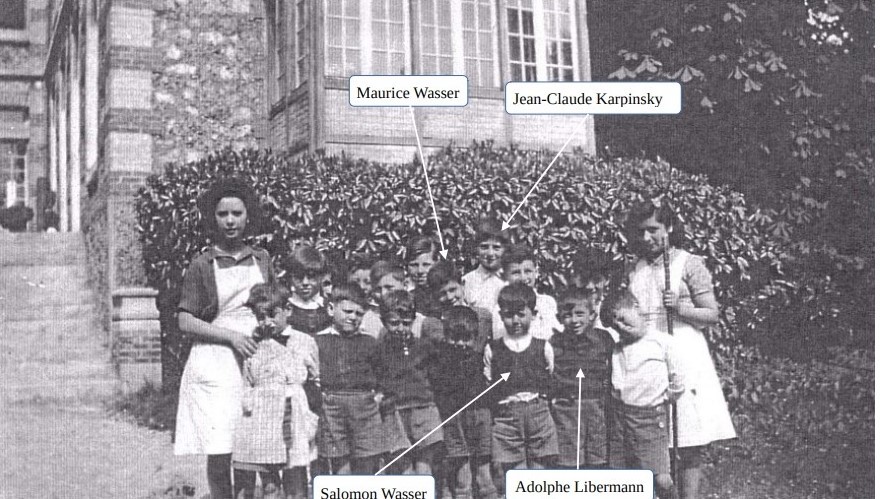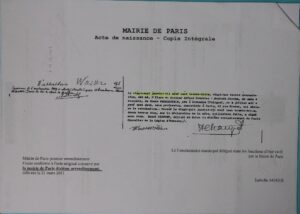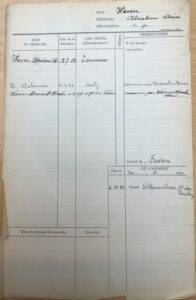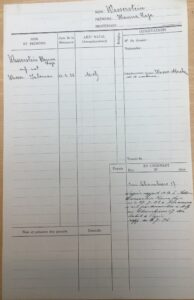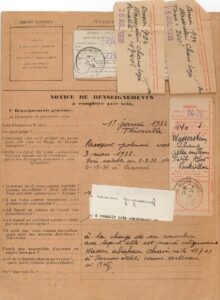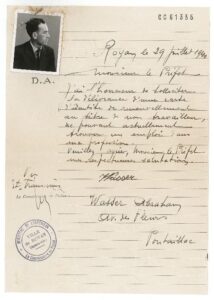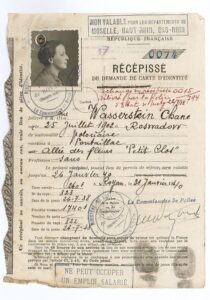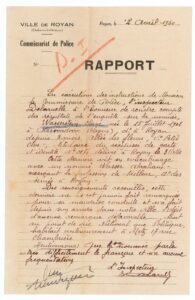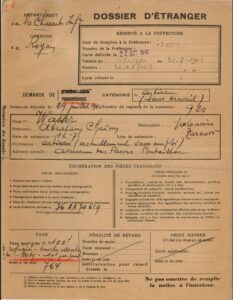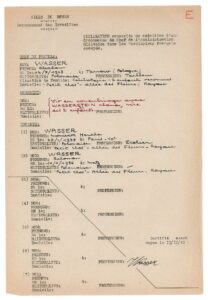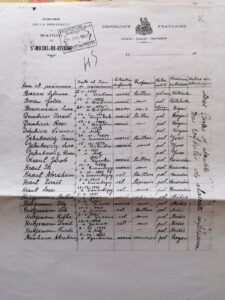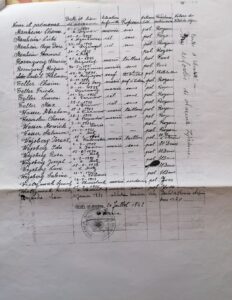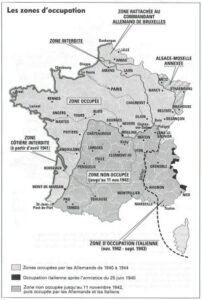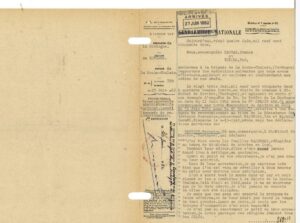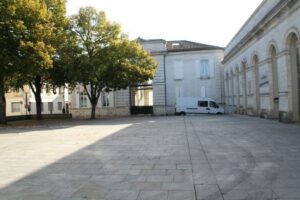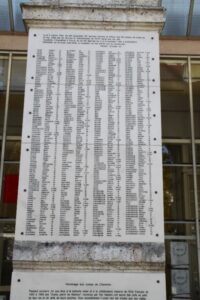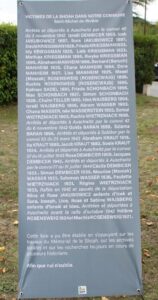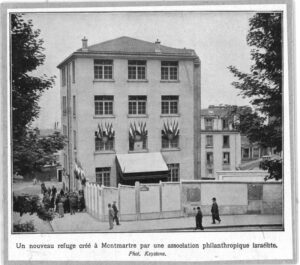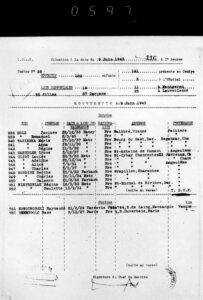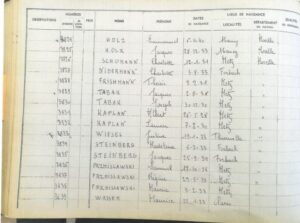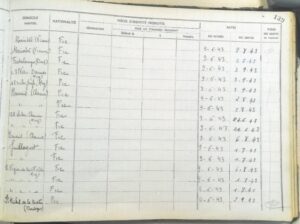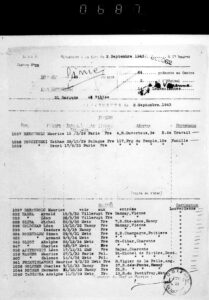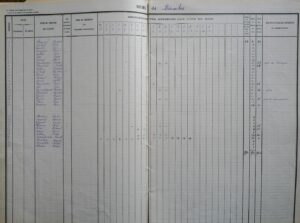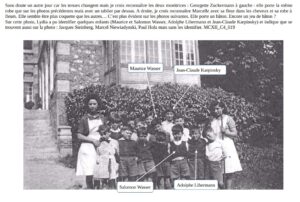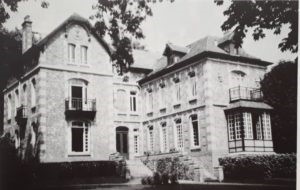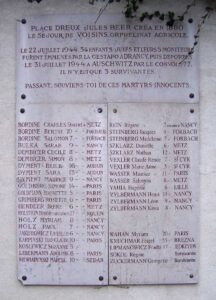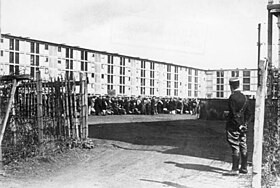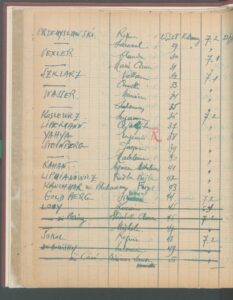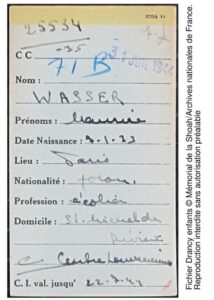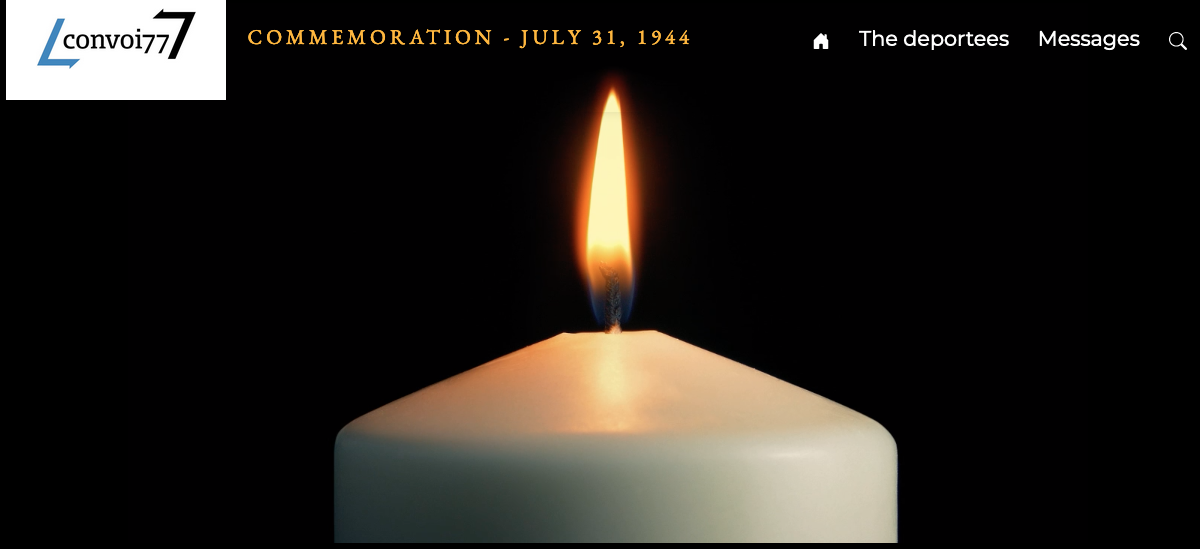Maurice WASSER
Photograph of a group of children in Louveciennes, probably taken in spring 1944.
(Shoah Memorial, Paris).
We began our investigation by reviewing the list of people deported on Convoy 77, the last transport from Drancy to Auschwitz, which left on July 31, 1944. The list is from the Arolsen archives – International Center on Nazi Persecution, which is the world’s most important archive on the victims and survivors of Nazi (National Socialist) persecution. The archives are listed in the UNESCO Memory of the World Register.
Maurice and Salomon Wasser’s names are both on the list. It includes information about the brothers, such as their dates and places of birth, and where they last lived. Maurice was born on January 27, 1933 in Paris, Salomon on April 14, 1936 in Metz, in the Moselle department of France. The last place they lived was St Michel de Rivière in the Dordogne department.
In this biography, we attempt to piece together Maurice’s life.
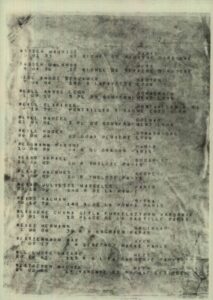
Extract from the Convoy 77 deportation list
(Arolsen archives)
Below is a copy of Maurice’s birth certificate. It dates from 2011, when Maurice was officially acknowledged to have been a victim of deportation. It is included in the file on him held by the French Defense Historical Service in Caen, Normandy. Maurice was born at 9:45pm on January 27, 1933 at the Saint Louis hospital in Paris. His mother was Hanna Laja (often known as Chana ) Wasserstein, who lived at 47 rue Bisson in Paris. It was not until September 6, 1939, in Metz, that Abraham Chaim Wasser officially acknowledged that Maurice was his son. He may have done so in an attempt to protect the child, given that war had just broken out. He had, however, acknowledged that he was the father of Maurice’s brother Salomon as soon as he was born, in 1936.
Copy of Maurice Wasser’s birth certificate
(French Defense Historical Service archives).
I. Life in Metz and Paris in the 1930s
We know very little about the family’s life during the 1930s. As Abraham and Chana were not legally married under French law, they had separate residence records. Interestingly, however, we were able to glean a few more details from their foreigners’ files, which are held in the Charente-Maritime departmental Archives. Not only did we discover that family sought refuge in Charente Maritime in 1940, but we have their identity photos.
Abraham Chaim Wasser was born on July 12, 1903 in Tarnow, Poland. According to his residence record, he moved Metz in November 1931, having first arrived in Sedan, in the Ardennes department of France. He was unemployed at the time, but later worked as a tailor. Chana, who also came from Poland, was born in Rosvadow on July 25, 1902. She may have had a brother, Bernard, born in the same town in 1899, who moved to Metz in 1926. According to her foreigner’s file, she arrived in Thionville, a town north of Metz, on January 1, 1932, and had only married Abraham in a religious ceremony (this means that they must have got married in Poland, because had they married in France, they would also have had to be legally married in their local town hall). They then moved to 17 rue Chambière in Metz, which is the only address we have for them in Metz. Chana does not appear to had a job. According to a report drawn up in Royan, in the Charente Maritime department, in April 1940, she spoke very little French. According to her residence record, she also appears to have lived in Paris, which is where Maurice was born. The fact that the family spent time living in both cities may be the reason that their names are not included on the memorial plaque at the Polish synagogue in Metz. The French National Archives service told us that they have applications for French citizenship for both boys, which suggests that their parents were keen to integrate into French society.
Abraham Wasser’s residence record
(Metz municipal archives)
Chana Wasserstein’s residence record
(Metz municipal archives)
Information sheet from Chana Wasserstein’s foreigner’s file
(Charente Maritime departmental archives)
Documents from Abraham and Chana’s foreigners’ files, including photographs of them
(Charente Maritime departmental archives)
II. The family in Royan in 1940
Soon after the outbreak of the Second World War on September 3, 1939, many people from Metz, in particular Jewish families, fled to Royan in what was then the Charente Inférieure department of France, but is now called Charente Maritime. A number of records, including census returns and Abraham and Chana’s foreigners’ files, confirm that the Wasser family lived in a villa called “Petit Clos”, on Allée des Fleurs in the Pontaillac district of Royan.
Chana’s foreigner’s file contains a police report written by an Inspector Delaruelle on April 2, 1940, which states that she had been living in Royan for three months. The family must therefore have arrived there in late December 1939 or early January 1940. It also states that she had difficulty speaking French and had no acquaintances in the town. Abraham was working as a tailor on Avenue des Semis at the time. Abraham’s file includes a note made in July stating that he was out of work and receiving a welfare payment of 10 francs a day from the Metz city council.
The Germans occupied Royan and the surrounding area from June 1940 onwards. In October 1940, they ordered all Jews to take part in a census. The Wasser family did as they were told, and went to register themselves. From that moment on, their fate was sealed. A summary sheet dated December 1940 reveals that they were taken to Angoulême, in the Charente department, on November 23.
Inspector Delaruelle’s report, dated April 1940, from Chana Wasserstein’s foreigner’s file.
(Charente Maritime departmental archives)
Record from Abraham Wasser’s foreigner’s file
(Charente Maritime departmental archives)
The Wasser family’s census form, dated October 15, 1940
(Charente Maritime departmental archives).
Page from the December 1940 census of foreigners in Royan
(Charente Maritime departmental archives)
III. The family relocated to Saint-Michel-de-Rivière (1940-1942)
In 1940, the Germans declared the Atlantic coastal zone a no-go area for Jews. Although the report states that the Wasser family was taken to Angoulême, they were actually sent to a little village called Saint-Michel-de-Rivière, just a few miles north of the demarcation line. In those days, the village was in a small corner of Dordogne in the occupied zone, and as such was temporarily attached to the Charente department. Angoulême is the largest city in Charente, and the main administrative center. The family spent two years in Saint-Michel-de-Rivière. Another census of foreigners was carried out on July 20, 1942 and the records state that they were one of a number of families relocated to Charente Inférieure. Chana’s surname is listed in the census data as Wasser, rather than Wasserstein. We asked the town halls in both Royan and Saint-Michel-de-Rivière to check their registers to see if she had married Abraham during her time there. They said that she had not, so we suppose she simply felt it easier to use his surname. Maurice and Salomon are also listed in census data, which states they were Polish citizens. We have no further information about the two years the boys spent in the Dordogne, but even though there are no school registers to prove it, they must have gone to school in the village.
The 1942 census also served as a basis for the roundup that took place the following October, during which children were separated from their parents.
Census of foreigners living in Saint-Michel-de-Rivière in July 1942
(Dordogne departmental archives)
Map of occupied zones in France, 1941 – 1943
French Resistance historical dictionary, published by Laffont, 2006.
IV. Maurice and Salomon separated from their parents during the roundup in Angoulême
A French military police report drawn up in 1952, as part of an investigation into the arrest of the Wajsberg family, another Jewish family from Metz who also lived for a time in Saint-Michel-de-Rivière, details the circumstances surrounding the arrest of Maurice and Salomon’s parents. At around 2 a.m. on the night of October 8-9,1942, a group of French military police arrived in the village, arrested all the Jews in the village, loaded them onto a bus and took them to the Philharmonic Hall in Angoulême. A total of 442 Jews from all over the Charente and occupied Dordogne were rounded up and held there. 387 of them were transferred from Angoulême to Drancy on October 15, and then deported to Auschwitz on Convoy 40 on November 4, 1942. Among them were Maurice and Salomon’s parents, who were probably exterminated as soon as they arrived at the camp. A plaque commemorating the roundup was unveiled in Angoulême on October 8, 2012, and another in Saint-Michel-de-Rivière on October 8, 2022.
What happened to Maurice and Salomon is not clear. Although they were listed as Polish nationals a few months earlier, it would seem that they were actually French citizens. This suggests that they were arrested at the same time as their parents, but when they showed the identity papers, were handed over to a Christian charity for a month or so, and then taken in by a French Jewish family. However, this is only speculation, and there is no evidence that the two boys were placed with the same family.
French military police investigation into the arrest of the Wajsberg family, dated 1952
(French Defense Historical Service archives)
Photos of the Philharmonic Hall in Angoulême, now the Gabriel Fauré Music Academy, and of the plaque commemorating the roundup, inaugurated in 2012
The memorial unveiled in Saint-Michel-de-Rivière on October 8, 2022
V. Maurice and Salomon at the Lamarck center (summer 1943)
We have no accurate information about what happened to the boys over the next few months. They were orphans by then, although probably did not know that. All we know is that they arrived at a UGIF shelter called the Lamarck Center (center no. 28) on June 9, 1943. According to the Convoy 77 website, the Lamarck center, which was in the 18th district of Paris, was a former reception center for Jewish immigrants that was converted into a UGIF shelter after the round-ups that took place in July 1942. It was able to accommodate a large number of children: in May 1943, over 160 were staying there. It was primarily a transit center, where most of the Jewish children who had been separated from their parents were sent, after which some of them were transferred to other UGIF homes.
According to the official report drawn up the day they arrived, Maurice and Salomon had been transferred there from the Charente department. However, although it states that several other children had been transferred from Angoulême to Paris, it does not say which town or village the Wasser brothers had been staying in. This suggests that they had not been staying in Angoulême itself. On the center’s admission register, in which children are not listed in alphabetical order, the two boys are not listed on the same page, which suggests that they were not waiting in line together. Just over a week later, on Sunday July 18, they were separated for a short time: unlike his younger brother, who was allowed to spend the day with a Jewish family, Maurice was not on the list of children who were able to experience some semblance of family life.
The brothers stayed at the Lamarck center for less than three months. On September 2, 1943, they were moved to another UGIF center, in Louveciennes, about 15 miles west of Paris.
Photo of the Lamarck center early in the 20th century
Lists of arrivals and departures at the Lamarck center on June 9, 1943
(Shoah Memorial, Paris)
A page from the Lamarck center admission register, June 9, 1943
(Montmartre Jewish center, Paris).
List of arrivals and departures at the Lamarck center on September 2, 1943
(Shoah Memorial, Paris)
VI. Salomon and Maurice at the UGIF center in Louveciennes (September 1943 – July 1944)
The UGIF center in Louveciennes, center number 56, was based in a former agricultural orphanage called Séjour de Voisins, on Place Ernest Dreux. The Germans requisitioned the building in December 1943, after which it moved to a villa on rue de la Paix.
Maurice and Salomon went to the local school. Their names are listed in the attendance registers. Maurice, who was ten years old in 1943, only missed school once, for two days in December, and the reason given was “no shoes”. This reveals how hard day-to-day life could be at the time, especially for Jewish orphans.
In an interview with Richard Niderman held shortly before she died in November 2024, Auschwitz survivor Denise Holstein, who was interned and helped to supervise nine children in Louveciennes, said that she did not remember the Wasser brothers.
Catherine Tanguy, a history and geography teacher in Ploemeur, in the Morbihan department of France, sent us a group photograph kept at the Shoah Memorial. A woman named Lydie had identified Salomon and Maurice in it. The photo, which, judging by the foliage and the light clothing, outfits, may have been taken in spring 1944, is the only known photo of the two brothers. In some photos taken in Louveciennes, probably taken around the same time, the children are playing and smiling. It would seem that everything possible was done to make their lives as normal as they could be in the circumstances.
What may have been a reasonably happy episode in the children’s troubled lives came to an abrupt end in the early hours of the morning of July 22, when Aloîs Brunner and his men arrested the children, supervisors and staff and took them to Drancy camp. A commemorative plaque outside the villa on rue de la Paix, on which the victims’ names are all listed, reminds passers-by to spare a thought for them.
Attendance register of a boys’ class at the Louveciennes elementary school, 1943-1944
(Leconte de Lisle school, Louveciennes)
Photo of a group of children in Louveciennes, probably taken in spring 1944, including Maurice and Salomon Wasser, Jean-Claude Karpinsky and Adolphe Libermann
(Shoah Memorial, Paris)
Photo of the UGIF center n°5 on rue de la Paix in Louveciennes.
Plaque commemorating the roundup that took place in Louveciennes on July 22, 1944
VII. Salomon and Maurice interned in Drancy camp (July 22-31,1944)
Drancy camp, north-east of Paris, was the main hub of the anti-Semitic deportation policy in France from August 1941 to August 1944. The vast majority of Jews from France spent time in this camp prior to being deported to Auschwitz. Salomon and Maurice, whose names are listed in the camp transfer book, were among them. They were registered together and both were put in room 1 on staircase 7. They were assigned two consecutive serial numbers: Maurice was number 25534 and Salomon number 25535. Both were deported, along with almost all of the children arrested in UGIF centers at around the same time, on July 31, 1944 on Convoy 77, the last major transport of Jews from Drancy. We have no further details about the deportation. We do not even know if Maurice and Salomon survived the appalling journey. Crammed into cattle cars for three days and three nights, with 80 to 100 people in each car, the deportees were barely able to sit down or sleep, had almost nothing to eat or drink, and had only a bucket in which to relieve themselves. If they made it to Auschwitz alive on August 3, 1944, they were probably sent straight to the gas chambers and murdered. Salomon was only 8, while Maurice was 11.
We must never forget these two young Holocaust victims.
Photo of Drancy camp
Drancy camp arrivals register no. 15, page dated July 22, 1944
(French national archives, ref. F/9/5788)
Drancy internment record for Maurice Wasser
(French national archives, ref. F9 5748)
Photo of the Wall of Names at the Shoah Memorial in Paris, taken during our visit on January 29, 2025
Acknowledgements: We would like to thank everyone who helped us with this project, in particular Gérald Sim, history and geography teacher in La Rochelle, who provided us with numerous documents that were extremely useful during our investigation.


 Français
Français Polski
Polski